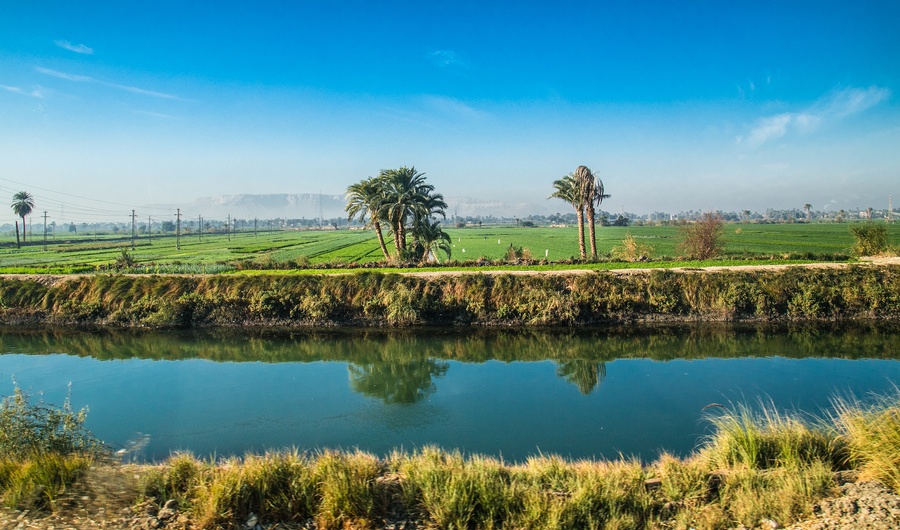Volcanic Eruptions May Have Contributed to Unrest in Ancient Egypt

A Nile River irrigation canal, which provides water to farmlands in the river valley.
Aleksandar Todorovic via Shutterstock
(Inside Science) -- Using climate modeling, a group of scientists have found that four closely timed volcanic eruptions around the world over 2,100 years ago might have led to less flooding of the Nile River, which would have deprived the valley of water needed for agriculture. A strain on farming could have contributed to revolts and social unrest seen in ancient Egypt at the time.
River flooding was "the lifeblood of a place like Egypt," said Joseph Manning, a historian at Yale University who specializes in Egypt's Ptolemaic period, which lasted from 305 to 30 B.C. Manning leads a broader Yale Nile Initiative that the modeling is a part of.
Ram Singh, one of the modelers and a postdoctoral research scientist with Columbia University's Center for Climate Systems Research in New York, and the NASA Goddard Institute for Space Studies, said that a lack of flooding could have contributed to crop failures, stirring discontent within Egypt and heightening tensions with neighboring kingdoms. Singh presented the research at a virtual poster session during last month's American Geophysical Union meeting.
The Yale Nile Initiative uses historical records, hydrological modeling, climate modeling, ice core geochemistry and other tools to better understand the relationship between volcanic eruptions, climate, the Nile River and society during the Ptolemaic period.
In a 2017 paper in the journal Nature Communications, Manning and colleagues reviewed both ice core data containing evidence of volcanic eruptions and historical measurements of and writing about Nile River flooding. They showed that throughout history, volcanic eruptions have consistently been followed by a drop in Nile flooding. The paper authors also found that eruptions coincided with the starts of revolts, the ends of wars with the rival Seleucid Empire to the east, and socioeconomic stress during the Ptolemaic period.
Singh and his collaborators focused on 168 to 158 B.C., a period that Manning called "a pivotal decade in Mediterranean history." Rome had been amassing power in the region throughout the second century B.C. and won a crucial war against Macedonia in 168 B.C., putting "huge external pressure" on states such as Egypt, he said.
The researchers hypothesize that the four eruptions they studied occurred in modern-day Philippines, Iceland, Alaska and eastern Russia. A 2015 paper in Nature, whose authors include contributors to the Yale Nile Initiative and the 2017 Nature Communications paper, reported estimates of sulfate emissions of these eruptions based on data from ice core samples. Singh and his collaborators' climate model used the sulfate levels to approximate the strength of the four eruptions. They combined the eruption strengths with estimates of the period's climate to try to gauge the particular effects this unique event -- four eruptions in quick succession -- might have had on the Nile.
In general, volcanic eruptions contribute volcanic ash and sulfate aerosols to the atmosphere that shade the planet from the sun's radiation, cooling Earth's atmosphere. Singh said northern hemisphere eruptions affect the movement of a tropical zone in the atmosphere that is a source of rain. The cooler northern hemisphere isn't able to pull this moisture-laden belt as far northward as usual during the monsoon season, so areas such as the Ethiopian highlands get less rain.
Rainfall in this region contributes to the Blue Nile River, a source of 80% of the Nile's water during the rainy season. Egypt itself gets little to no rainfall, so ancient Egyptians needed the river to flood to water their crops, which included wheat, barley, beans and lentils.
Manning said that it "is now accepted in the literature that explosive volcanic eruptions impact the monsoons."
But the specific effects of a particular eruption or series of eruptions can vary. "Volcanologists will insist that every volcano and every eruption of every volcano is distinctive," said Manning.
Singh and his colleagues' research showed that, in the modeling, the four eruptions they considered did indeed lead to cooler northern hemisphere air temperatures and a drop in monsoon rainfall over the Nile River basin, as well as a weaker river flow where the Nile meets the Mediterranean Sea.
Manning said the model results help paint a clearer picture of disruptions to farming that he and his colleagues have found in historical records from this period. "There are some fantastic texts that talk about what looks like tremendous distress with irrigation systems and agricultural production," he said. Singh said that during this period, Antiochus IV, the emperor of the Seleucid Empire, tried to invade Egypt twice, but was stymied by the Romans, who relied on Egypt for grains and wanted to prevent the Seleucid Empire from consolidating power.
"The modeling is really helpful because it sort of confirms our suspicion that yeah, actually, this looks like a pretty crappy decade," Manning said. "There's probably a pretty serious impact of these eruptions on the Nile watershed."
A group of researchers that includes Singh and Manning are working on a paper based on the research.
